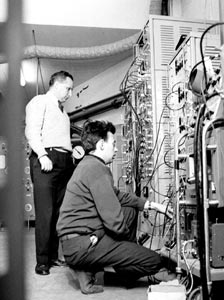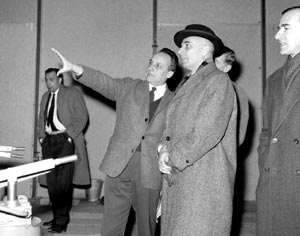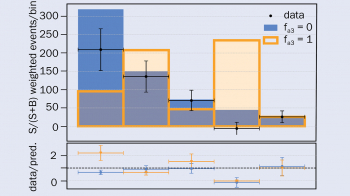I have been asked to speak here not so much because of my personal recollections of Willibald Jentschke, but to speak on physics at CERN during his regime. There are two subjects that come to mind here: the J/Ψ and neutral currents.

I have tried to find out why the J/Ψ was not discovered at the ISR. This turns out to be impossible. Whenever you ask questions about this the answer is different depending on the person asked. That horror story is therefore not easily unravelled, and I will not try that here.
So let me turn to neutral currents as seen from my own perspective. I would like to start in 1968, when I drifted in that direction. First let me sketch the state of affairs at that time. Particle theory was utterly dominated by Gell-Mann. To paraphrase what a CERN theorist once told me: “If Gell-Mann tells us to start standing on our heads on our chairs, we will do so.”
Theorists were busy with the latest invention of Gell-Mann, the algebra of currents. What was this thing, now largely forgotten? Essentially, it amounted to the following. Assume the existence of vector bosons of the weak interactions, and assume they are coupled according to some Yang-Mills theory. That implies some properties for the currents to which these bosons are coupled, and in fact this implies an algebra for these currents, among other certain commutation rules. Now forget about the vector bosons, and assume this algebra of currents to be correct. This was not precisely the way Gell-Mann formulated things, but it makes it easier to understand. He did not talk about vector bosons.
Of course, everyone started doing algebra of currents. The breakthrough came with the derivation of the Adler-Weissberger (AW) sum rule, an experimentally verifiable rule, which indeed checked out. At that point I became interested in this matter, and as I am never very clear on the physical meaning of commutators I tried to derive the AW rule in another way. This led to what I called divergence conditions, a set of equations for the currents. It was John Bell who closed the circle by pointing out that my equations would follow if one assumes a Yang-Mills structure for the weak interactions. I then deviated quite quickly from the Gell-Mann doctrine by assuming that these currents were coupled to real vector bosons. That is why I started investigating Yang-Mills field theory (or gauge theory) in 1968. More particularly, I focused on the problem of renormalizability. In that I was virtually alone.
Physics of weak interactions at that time was largely phenomenology. There was the (non-renormalizable) Fermi theory of weak interactions and the V-A theory of Feynman and Gell-Mann. The Cabibbo theory was generally accepted, and indeed may be seen as the great breakthrough in the early 1960s. In addition there was a set of isospin selection rules, of which I will give an example, namely the ΔI = 1/2 rule for non-leptonic weak decays.
Consider the decay of a K-meson into two pions. Two pions in a state of zero angular momentum can only be in a symmetric state, which then excludes the isospin state 1. Since the K-meson has isospin 1/2 the ΔI = 1/2 isospin selection rule forbids the decay to the isospin 2 state. But an isospin 0 state of two pions is necessarily a neutral state, and therefore the decay of the K+ into two pions with total isospin 0 is forbidden by this ΔI = 1/2 rule. And indeed, the amplitude for K+ decay into two pions is only 5% of the corresponding K° amplitude; stretching the imagination you could attribute this 5% rate to electromagnetic interactions, breaking isospin. Personally, I believed the ΔI = 1/2 rule, and started doubting it only when the weak decays of the Ω– became known. There this selection rule does not work very well.
Now back to field theory. When you start with Yang-Mills theories, you immediately wind up with charged and neutral vector bosons. There is absolutely no way to avoid that. The question is how the neutral vector boson is coupled to the fermions – the hadrons and leptons. In addition, there is the point that in Yang-Mills theories the vector bosons are massless, so you have to do something to give them mass. Whatever you do, this generally implies an arbitrariness in the masses of the charged and neutral vector bosons. In particular, the neutral vector boson mass simply becomes a free parameter, next to the charged vector boson mass.
Sheldon Glashow, doing Yang-Mills phenomenology in the early 1960s, gave the vector bosons a mass by hand. A difficulty was the absence, experimentally, of neutral currents in strangeness changing decays. Why was there no decay of the type K → π + ν + νbar involving (in present-day notation) a Z° decaying into two neutrinos? Had that decay existed we might have known about three neutrinos a long time ago. But it does not exist. Why not? Glashow proposed that the Z° was very, very heavy. That was his way out.
When I started on Yang-Mills theories I of course met these problems. Making the Z° heavy was an inelegant option. Of course, it was also totally unclear how the vector bosons coupled to the hadrons. There is another really big difficulty. There is essentially no way that you can generate the above-mentioned isospin selection rules using any set of vector bosons with or without neutral ones. Smart schemes were proposed, and I may mention the Schizon theory of Lee and Yang in which the vector bosons sometimes behaved as isospin triplets and sometimes as isospin doublets. When you believe in a Yang-Mills structure, that is not really a viable scheme. You cannot change symmetry from one configuration to the next.
In 1968 I took a memorable sabbatical to the University at Orsay outside Paris, joining the group of Claude Bouchiat and Philippe Meyer (and later Jean Iliopoulos). They were the remnants of particle theory in France. Bouchiat was a student of Louis Michel, and allow me to tell you an anecdote related to me by Michel, to depict the state of affairs in France at that time.

Michel became a theorist at the Ecole Polytechnique (EP) as the leadership of that institution felt that they needed a theorist – as decoration if nothing else. So Michel sat in an office and was generally left alone. However, from time to time Louis Leprince-Ringuet, the director of the EP, would open the door and show Michel to some visitors, saying: “Voilà notre théoricien.” After that he would slam the door closed again. The atmosphere at the time was not very conducive to particle theory. Somewhat complicated issues such as vector bosons, charged and neutral, with their isospin properties did not excite anybody. Anyway, I was invited to give a seminar at the EP and I decided to talk on the above-mentioned issues. The title was “For a few dollars more”. The response of the audience was nil, zero.
You may understand my lack of success at the seminar. Trying to explain the problems of such things as isospin selection rules and neutral vector bosons to that audience was simply a waste of time. Note that today we believe that the isospin selection rules are accidents, caused by other mechanisms. The question is not really completely understood.
There is another story I would like to relate. Once Jacques Prentki and I were chatting on the stairs of the College de France and by chance a photographer from the magazine L’Express chose that moment to take a picture of the institution. In due course, Prentki and I appeared on the cover of the magazine. What did not appear was the subject I was arguing about with Prentki, namely the wisdom of building bubble chambers at that point in time. I more or less said the following: “You know Jacques, any Frenchman of any self-esteem in the business of particle experiment wants to make a bubble chamber. From the success of the first bubble chamber at the EP they conclude that this is the way to greatness. So there is Lagarrigue’s Gargamelle, Berthelot’s Mirabelle, Peyrou’s BEBC and Badier’s rapid cycling bubble chamber. While the whole world is going over to spark chambers, they are still hanging onto this obsolete type of instrument.” All but Badier’s chamber were built.
I argued the same thing to André Lagarrigue, at a lunch in Orsay. Understandably he was not happy, and he made that clear in no uncertain terms. In retrospect, I was too harsh and in fact wrong. No experimenter is free to change direction in the middle of an experiment. Lagarrigue had started Gargamelle quite some time before, and I do not think that stopping was an option. Furthermore I must say that BEBC and Gargamelle have given us good physics, and that in the end is what is important. For this reason I dedicated a 1976 article in La Recherche to Lagarrigue. Here is the (original) English dedication: “This article is dedicated to the memory of Prof. A Lagarrigue, who was the driving force behind the Gargamelle bubble chamber group. It was this group that discovered first the neutral current events and charm-type events that are so crucial for the theories described in this article.”
The article appeared in French in La Recherche 7 p617 (issue 69, July-August 1976). I still think it is a proper and just dedication.







